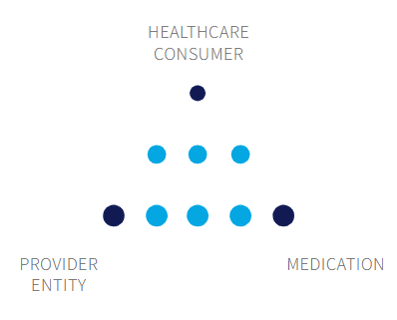Insights
Demystifying the Medication Use Process
A deeper look at Healthcare Consumers
RevityRx’s medication use process (MUP) model illustrates the interdependent relationships between the stakeholders or nodes involved in the process. The nodes are Provider Entities, Healthcare Consumers, and the Medication. The model aims to simplify the complex MUP and establish a mutual understanding of the nodes at a high level. For a greater appreciation of the process complexity, exploration into each node’s composition will identify MUP levers to transform a siloed collection of activities into a comprehensive medication stewardship framework. This Insight provides an overview of the Healthcare Consumer node. It establishes a framework to methodically deconstruct the node from consumers who use and purchase medication and related services to the granular individual and entity level.

Who is the Healthcare Consumer?
Within the MUP, the Healthcare Consumer node is the collection of stakeholders impacted by a medication’s therapeutic effect, responsible for payment, or influence the type or location of service. There are three distinct components: the patient, the plan sponsor, and the health plan.
The crucial member of this node and the entire MUP is the patient, including family members, friends, and caregivers. The next member of the Healthcare Consumer node are plan sponsors who provide a collective health benefit for their patients or members. Plan sponsors include government programs, public and private employers, and faith-based groups. The Healthcare Consumer node’s third component are health plans, such as insurance plans and managed care organizations. While not traditionally considered a consumer, health plans are placed into the model’s consumer node since they are responsible for medication payment.
Healthcare Consumers and the MUP
The Healthcare Consumer node components are diverse, each with a different understanding of healthcare delivery that spans from layperson to healthcare industry insider. It is crucial these differences are recognized to best understand how patients, plan sponsors, and health plans interact with the MUP. Across the node, the perceived quality and the measures of success vary and, in some instances, may seem contrary. RevityRx evaluates how consumers interact with the MUP across six factors: Process Knowledge, Duration, Assumed Risk, Price Sensitivity, Expectations, and Quality Focus.
Process Knowledge relates to the degree a component understands the MUP and healthcare delivery or the accessibility to objective subject matter experts.
| Process Knowledge | |
| Awareness | Details |
| Layperson | Individual or entity is a participant with no or cursory understanding of the MUP or healthcare delivery. This segment relies on others for guidance or advice on how to proceed through the process. |
| Informed | Individual or entity has a high-level understanding of the MUP or healthcare delivery. This subset is not part of the healthcare industry but may contract with subject matter experts to navigate process nuances. |
| Insider | Individual or entity is part of the healthcare industry routinely engaged in one or more areas related to care delivery, healthcare operations, or healthcare financing. |
Duration references the period activities or outcomes from the MUP impact a specific Healthcare Consumer component.
| Duration | |
| Period | Details |
| Permanent | Long-term and enduring beyond the confines of therapy duration. |
| Affiliation | An intermediate to long-term timeframe that is often greater than one year but less than permanent. It is a function of the relationship between consumer components, such as employment or belonging to an organization that pools healthcare resources. The relationship is finite but with a more open-ended duration. |
| Contractual | A short to intermediate timeframe less than one year but may last for several years. It is a function of a contract between an individual or organization that has a finite term defined in a legal agreement. |
Assumed Risks account for what is at stake when a consumer engages in the MUP. Healthcare Consumers may solely burden risk or share risk with other Healthcare Consumer components. For simplicity, risks are summarized as:
| Assumed Risks | |
| Risks | Details |
| Health | Entity's state of physical and mental wellbeing |
| Fiduciary | An entity who is responsible for acting in the best interest of an individual or entity |
| Financial | The entity responsible for payment of a product and services. |
| Social | Entity's publicity attributed to involvement and actions in the MUP. |
Price Sensitivity assesses a component’s perception of the value attained for each individual or entity’s cost related to MUP. Ratings range from a more subjective or emotional perception to a more objective or metric-driven assessment.
| Price Sensitivity | |
| Rating | Details |
| Affordable | The perception that the costs of a transaction or episode are reasonably priced. Predominantly a subjective rating based on an individual's or entity's ability and willingness to pay and the perceived value achieved. |
| Economical | Cost-minded with greater emphasis on cost reduction to achieve value compared to a broadening of scope or variety. |
| Performance | Pragmatic, balancing the cost with the historical outcomes achieved. |
Expectations are characteristics or actions consumers anticipate from the MUP.
| Expectations | |
| Characteristics | Details |
| Choice | Opportunity for input on alternatives |
| Empathic | Understanding of individual or entity's position or feelings |
| Equitable | Unbiased, evidence-based with consideration for unique characteristics of an individual or entity |
| Intuitive | Easily understand and straightforward from step to step |
| Reliable | Consistent and repeatable outcomes |
| Transparent | Provides valuable and actionable information about price, quality, and experience |
Quality Focus rates the emphasis a consumer places on experience versus service or a blend of both.
| Quality Focus | |
| Focus | Details |
| Experience-focused | Relates to how coordinated or smoothly a consumer perceives MUP execution; this is predominately a subjective observation based on the level of friction an individual or entity encounters navigating the process. An important caveat is experience-focused consumers evaluate or score friction at a granular level. For these consumers, a single interaction or experience may supersede the cumulative experience. |
| Service-focused | Relates to the reliability of the MUP execution and delivery of consistent outcomes. Unlike the experience-focused group, this group is predominately an objective observation based on the cumulative outcome of populations navigating the MUP. Measures that establish service quality are speed to therapy initiation, adherence to therapy, completing therapy, etc., as a function of a population receiving similar therapy. |
| Blended-focused | Consumers place nearly equal weight on experience and service. While this group leans more toward a cumulative observation across the MUP, this group may swiftly change its attitude when there is an increase in process variation. |
These factors serve as a guide to assist clients in MUP design and quality improvement. Understanding each component’s quality-of-experience versus quality-of-service requirements allows for deeper awareness of the factors driving this focus. With greater clarity of these MUP interactions, unique opportunities present for Provider Entities to tailor an enhanced experience for Healthcare Consumers.
Further exploration into the composition of each node of RevityRx’s medication use process model will help clients identify levers to transform the MUP into a comprehensive medication stewardship framework. Learn more at www.revityrx.com.

